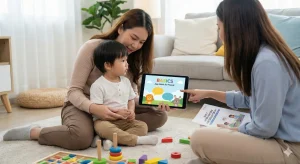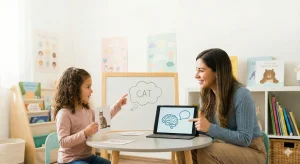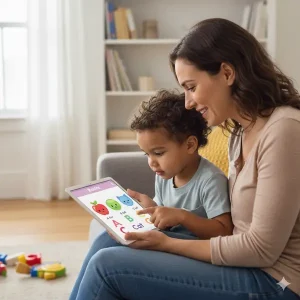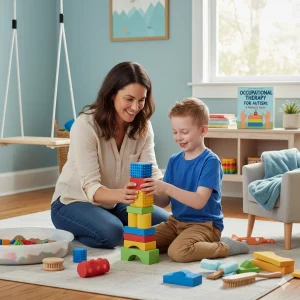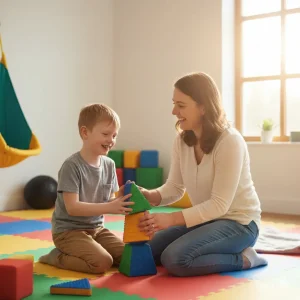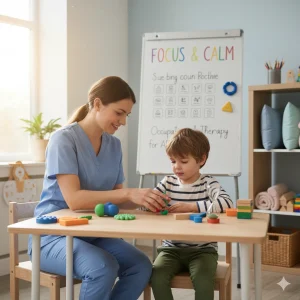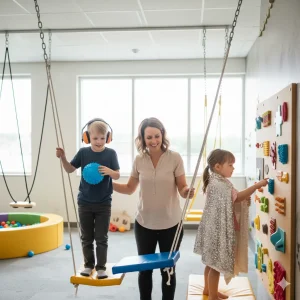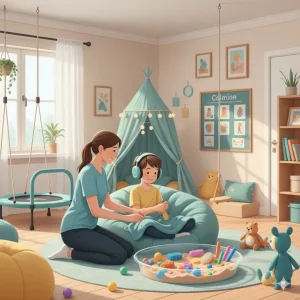Occupational Therapy for 14-Year-Olds: Focus & Calm
By Wellness Hub
Last Updated: October 22, 2025
Your 14-year-old is smart, capable, and full of potential — but lately, you might notice small cracks in their focus, organization, or emotional control. Homework takes forever, reminders lead to frustration, and simple routines—like packing a bag or starting an assignment—turn into daily battles.
If this sounds familiar, you’re not alone. As teens enter high school, their brains are juggling so much: changing hormones, heavier workloads, growing independence, and social pressures. For some kids, these changes make executive functioning — planning, prioritizing, and managing emotions — genuinely hard, not just a matter of “trying harder.” That’s where occupational therapy for 14-year-olds can make a real difference. Occupational therapists help teens strengthen focus, build organization systems that actually stick, and develop emotional regulation tools they can use anywhere — from the classroom to home life.
What Is Occupational Therapy for Teens?
Occupational therapy (OT) helps teenagers develop the real-world skills they need to succeed at home, in school, and in their communities. It focuses on everyday “occupations” — not jobs, but the meaningful daily activities that shape a teen’s independence and confidence.
In adolescent occupational therapy, these occupations often include schoolwork, self-care, organization, social participation, and emotional self-management. OTs work closely with parents and teachers to understand what’s challenging for your teen and design personalized strategies that make life easier and more balanced.
For example, therapy might include learning how to manage a homework schedule, keeping personal spaces organized, improving handwriting speed, or building self-regulation skills for handling frustration. Through structured, supportive sessions, OT empowers teens to build daily living skills that foster focus, resilience, and confidence.
At age 14, occupational therapy becomes even more meaningful because it’s not just about learning tasks — it’s about learning how to manage life. It gives your child the tools to think ahead, make decisions, and feel capable in both academic and social settings.
Also read: Occupational Therapy for 9-Year-Olds: Focus & Confidence
Why 14 Is a Turning Point
Turning 14 marks a major developmental shift — physically, emotionally, and socially. Puberty brings hormonal changes that can affect mood, motivation, and concentration. At the same time, school expectations rise sharply: more homework, tougher subjects, and greater responsibility for managing time and materials.
This is also the stage when independence skills start to matter more. Teens are expected to plan their own routines, remember deadlines, and handle emotional ups and downs without constant reminders. For many, that sudden jump in responsibility can feel overwhelming.
Occupational therapy helps bridge this gap. By supporting focus, emotional control, and executive functioning, OTs guide 14-year-olds through this complex transition with compassion and structure. It’s not just about improving performance — it’s about helping teens feel grounded, confident, and ready for the growing demands of high school and beyond.
Signs Your 14-Year-Old Might Benefit from Occupational Therapy
Every parent wonders if their teen’s challenges are “just a phase” or something that needs extra support. While every child develops at their own pace, certain patterns may signal that your 14-year-old could benefit from occupational therapy (OT).
Occupational therapy helps teens strengthen focus, organization, and emotional control — the foundation for independence. If you notice these signs, it may be time to explore how OT can help:
- Frequent lost assignments or materials — papers vanish between school and home, or folders are always disorganized.
- Incomplete homework or tasks — your teen starts but rarely finishes, even when they understand the work.
- Easily distracted — constant fidgeting, daydreaming, or jumping between tasks without completing them.
- Emotional meltdowns over small challenges — frustration, anger, or tears during homework or routines.
- Avoidance behaviors — procrastinating or refusing to start difficult or boring tasks.
- Poor sense of time — underestimates how long things take or forgets deadlines.
- Messy backpack, locker, or study space — cluttered environments that add to stress and confusion.
- Struggles with transitions — difficulty shifting from one activity to another, especially after screen time or school.
If these challenges are showing up daily and affecting school performance or family routines, OT can uncover the “why” behind them — not just fix surface behaviors.
Differentiating “Won’t” vs “Can’t”
It’s easy to assume a teen “won’t” focus, plan ahead, or follow through — but often, it’s not about motivation; it’s about capacity.
“Won’t” implies a choice — a lack of effort or interest.
“Can’t” points to a skill gap — your teen genuinely struggles with organization, focus, or emotional regulation because their brain’s executive functions are still developing.
Here’s the difference:
| Situation | Looks Like “Won’t” | Actually Means “Can’t” |
|---|---|---|
| Forgetting homework | “They’re careless.” | Working memory or time-management difficulty. |
| Meltdown over small issue | “They’re dramatic.” | Emotional regulation or sensory overload problem. |
| Avoiding chores | “They’re lazy.” | Trouble sequencing steps or sustaining attention. |
Occupational therapists use a “lagging skills, not bad behavior” approach — helping teens build the scaffolds they need to succeed. When parents understand this difference, frustration turns into teamwork, and home life becomes calmer and more cooperative.
How Occupational Therapists Assess Teens: Focus, Organization, and Emotions
When a parent brings their teenager for an OT assessment, the goal isn’t just to label a problem — it’s to understand how your teen’s brain, body, and emotions work together in daily life. Occupational therapists look beyond grades or behavior; they dig into what’s really making focus, organization, or emotional control difficult.
Here’s what a typical OT assessment for teens looks like:
| Step | What Happens | Purpose |
|---|---|---|
| 1. Parent & Teen Interview | The OT talks to both you and your teen about school routines, homework struggles, and emotional triggers. | To gather context and understand your family’s real concerns. |
| 2. Standardized Tests & Checklists | Tools like executive function tests, sensory profiles, or handwriting and coordination screens may be used. | To measure attention, organization, and self-regulation skills compared to peers. |
| 3. Classroom or Home Observations | If possible, the OT observes your teen in their natural setting—classroom, study area, or online learning environment. | To see how challenges appear in real-world tasks. |
| 4. Task Analysis | Your teen may be asked to complete everyday tasks like writing an essay, organizing a folder, or following a recipe. | To identify where the process breaks down — focus, planning, or follow-through. |
| 5. Collaborative Goal Setting | The OT creates goals with your teen, not just for them. | To ensure buy-in and motivation so progress feels personal and empowering. |
This process helps the therapist design a plan that fits your teen’s unique strengths, learning style, and emotional needs. It’s a blend of science and empathy — helping your teen build the executive function skills they need to stay calm, organized, and confident.
Understanding Executive Function
At the heart of every teen’s daily challenge — from forgetting homework to overreacting to stress — lies something called executive function. It’s the mental “control center” that helps us plan, organize, focus, remember, and manage impulses.
Think of executive function as your teen’s internal GPS: it keeps them on track when schoolwork gets tough, social life gets messy, or motivation dips. Strong executive function means your child can break big tasks into smaller steps, resist distractions, and bounce back from frustration.
There are three main parts:
- Working memory: holding information long enough to use it — like remembering essay instructions while writing.
- Inhibition: resisting distractions and managing impulses.
- Cognitive flexibility: adapting when plans change or something unexpected happens.
When these skills lag behind, it’s not a lack of effort — it’s a developmental gap. Sleep, stress, and hormones can all affect executive function during the teenage years. That’s why an occupational therapist doesn’t just teach “study skills” — they help your teen build the mental habits and coping tools that make success feel achievable every day.
OT Strategies to Improve Focus and Attention
If your teen struggles to start homework, stay focused in class, or drift off midway through chores, you’re not alone. Many 14-year-olds find it hard to manage long periods of attention, especially with distractions from screens, noise, and busy schedules. The good news? Occupational therapists use practical, research-based strategies that help teens strengthen attention while building independence.
Here are some OT-backed attention strategies you can try at home or in school settings:
Create a Focus Anchor:
A focus anchor is a simple cue or object that reminds your teen to return attention to the task — such as tapping a pencil, taking a deep breath, or quietly repeating a phrase like “back to work.” It trains the brain to reset when attention drifts.
Use the “Chunking” Technique:
Large assignments can overwhelm teens. Help them divide tasks into smaller, time-bound steps (e.g., read for 10 minutes → take a note → quick stretch). Completing one “chunk” at a time builds confidence and reduces avoidance.
Try the Pomodoro Routine:
Set a timer for 20–25 minutes of focused work, followed by a 5-minute sensory-motor break. These short bursts align with how the adolescent brain sustains attention. Use this method for studying, reading, or completing homework packets.
Incorporate Movement Breaks:
Physical activity boosts focus and oxygen flow. Quick wall pushes, stretching, or a short walk can reset attention and energy. Even 2–3 minutes between subjects can make a difference in sustained performance.
Use Fidgets with Rules:
Fidget tools (like stress balls or putty) can help restless hands focus — but set clear rules: quiet use, eyes on task, one tool at a time. Fidgets should help the brain filter distractions, not create new ones.
Reduce Visual and Auditory Clutter:
Too much stimulation — from bright posters, buzzing gadgets, or messy desks — can overload attention. Create a simple, quiet workspace with minimal visual clutter and low background noise.
Establish Predictable Study Routines:
Consistency matters more than perfection. Set a daily study “start ritual” — a short snack, glass of water, or calming breath — to signal the brain it’s time to focus. Over time, routines become mental shortcuts for productivity.
These strategies are rooted in classroom-based OT evidence showing that structured routines, sensory movement, and manageable goals improve both focus and academic performance. Small adjustments, when practiced daily, can make focusing feel achievable instead of frustrating.
Sensory Supports That Actually Help
Every teen’s nervous system needs balance between alertness and calm. That’s why sensory supports — or a “sensory diet” — can make a big difference in attention and mood. A sensory diet isn’t food-related; it’s a set of activities that give the body the input it needs to stay focused and regulated.
Here’s a quick Do / Don’t guide for parents trying sensory strategies at home:
| Do | Why It Helps |
|---|---|
| Offer heavy work before homework (carrying books, wall push-ups, wiping a table) | Builds proprioceptive input, calming the body and improving focus. |
| Set up a calm corner with soft lighting, a chair, and fidget tools. | Provides a safe space to reset before frustration escalates. |
| Use noise-canceling headphones or calming background music. | Minimizes sensory overload from loud or unpredictable sounds. |
| Allow gum or chewable items (if school rules permit). | Provides oral sensory input that improves alertness and concentration. |
| Start each homework session with a quiet ritual. | Signals transition from play to study, helping regulate arousal levels. |
| Don’t | Why It Hinders Focus |
|---|---|
| Overload with too many tools at once. | Too much sensory input can confuse the brain rather than calm it. |
| Use sensory activities as rewards only. | Teens need them proactively to regulate before stress builds. |
| Force participation. | Sensory preferences vary; forcing input can increase anxiety. |
Every sensory plan should be individualized — what calms one teen might overstimulate another. An OT will use data-driven sensory processing frameworks to find the right balance between alertness and relaxation.
With the right sensory strategies in place, parents often see powerful changes: homework gets smoother, emotional outbursts shrink, and teens begin to feel more in control of their focus and feelings.
Getting Organized: Systems That Teens Will Actually Use
Many parents of 14-year-olds say the same thing — “My teen’s backpack looks like a black hole!” It’s not laziness; it’s often a lack of system and executive functioning support. Organization is a skill that can be learned, especially with tools that feel simple, practical, and sustainable for teens.
Occupational therapists focus on school organization systems that teens can truly maintain, not just start. The key is making each tool visible, quick to use, and rewarding — what psychologists call a cue–routine–reward loop.
Here are some teen-tested organization tactics that OTs recommend:
| Tool / Strategy | Purpose / Benefit |
|---|---|
| The One-Book Method | Use one notebook for all subjects with colored sticky tabs. Reduces clutter and helps when switching classes. |
| Color-Coding System | Assign one color per subject — for folders, labels, and digital files. Helps visually separate and remember tasks. |
| Weekly Snapshot Planner | Every Sunday, write down upcoming tests, projects, and after-school events. Builds awareness of the week ahead. |
| Nightly Reset Routine | Spend 5 minutes every night cleaning out the backpack and laying out essentials. Prevents morning chaos. |
| “Home for Everything” Rule | Create a specific spot for school bag, charger, and supplies at home. Promotes consistency and reduces lost items. |
Time Management & Planning
One of the hardest parts of being a teen is time awareness — or what therapists call “time blindness.” It’s the feeling that deadlines sneak up out of nowhere or that five minutes feels like fifty.
Occupational therapy helps teens build time management and planning skills through structured steps and visual feedback.
Step 1: Backward Plan Big Tasks
Start with the due date and work backward. Break assignments into smaller pieces (research, outline, edit) and mark each on the calendar. This builds foresight and reduces last-minute stress.
Step 2: Use Visual Timers
Visual timers or hourglasses let teens see time passing, which helps them stay on task longer. For example, a red countdown timer can show how much “focus time” is left before a break.
Step 3: Compare “Estimate vs Actual” Time
After finishing homework, have your teen write how long it actually took. This builds self-awareness and helps plan future tasks more realistically.
Step 4: Add Buffer Blocks
Encourage adding 10–15 minute “buffer blocks” before or after transitions (e.g., before bedtime or study sessions). This helps teens shift tasks without feeling rushed.
Step 5: Visual Schedules Work Wonders
Post a daily or weekly visual schedule on a whiteboard, planner, or app. Seeing it daily reinforces predictability and time awareness — both key for independence.
These steps train the brain’s executive function system — helping your teen move from reactive to proactive behavior, one small success at a time.
Emotional Regulation Skills for Teens
The teenage years can feel like an emotional rollercoaster — one moment calm, the next overwhelmed. Hormones, pressure, and identity growth all play a role. Occupational therapists teach teens coping skills and self-regulation tools that help them understand, manage, and express emotions in healthy ways.
Here’s a simple self-regulation guide based on real OT strategies:
Use the “Zones of Regulation” Framework
OTs often teach teens to identify emotions using color zones — blue (low), green (calm), yellow (anxious), red (angry). This helps label feelings instead of acting them out.
Name and Normalize Feelings
Saying “I’m frustrated” or “I’m nervous about this test” helps reduce shame and builds self-awareness. When emotions are named, they become manageable.
Notice Body Signals (Interoception)
Help your teen tune into their body cues — sweaty palms, racing heart, clenched jaw — to recognize stress early. Awareness is the first step to control.
Try Breathwork or Grounding
Simple breathing techniques, like box breathing (inhale 4, hold 4, exhale 4, hold 4), can calm the nervous system and reset focus.
Practice the 3-Step Cool-Down Rule
When upset:
- Step 1: Pause and breathe.
- Step 2: Step away for a moment.
- Step 3: Return and problem-solve calmly.
Build a Self-Regulation Toolbox
Include calming items (fidget, journal, water bottle, headphones) your teen can access anytime. It’s a tangible reminder that regulation is a skill, not a reaction.
These self-regulation strategies are backed by therapy frameworks that combine neuroscience, sensory processing, and emotional coaching — helping your teen stay steady through life’s ups and downs.
Handling Homework Overwhelm and Test Stress
Homework meltdowns and test anxiety are incredibly common at this age — but they’re not about attitude; they’re about overload. When tasks feel too big or expectations too high, the brain’s stress system activates, shutting down focus and motivation.
Here’s a simple checklist to help your teen manage homework and test stress effectively:
- Take Breaks Before the Breakdown — Encourage short pauses between assignments or subjects to reset energy and prevent burnout.
- Set Micro-Goals — Instead of “finish your essay,” say “write one paragraph.” Small wins keep momentum going.
- Use Calm Scripts — Teach self-talk phrases like “I can do this one part” or “I’ve done hard things before.” Positive language builds resilience.
- Simplify Study Sessions — Alternate subjects, review small portions daily, and use visuals like charts or flashcards.
- Communicate with Teachers — If anxiety or overload persist, contact the teacher or counselor early. A small accommodation — like chunked deadlines — can make a big difference.
With these approaches, you’re teaching your teen that it’s okay to pause, regroup, and try again. Over time, they’ll develop both confidence and consistency — two key skills that support success far beyond school.
At-Home Routines That Build Independence
One of the most powerful ways to help your 14-year-old grow more focused and confident isn’t through extra homework — it’s through structured routines at home. Occupational therapists often say that consistency creates calm, and calm creates independence. When teens know what to expect, their brains use less energy managing chaos and more energy developing executive functioning skills like planning, initiation, and follow-through.
Here are simple, OT-inspired teen routines that make daily life smoother while teaching real-world skills:
1. Morning Routine That Builds Momentum
Mornings often set the tone for the day. A clear, repeatable morning routine helps teens practice sequencing, time management, and emotional regulation before they even reach school.
Step-by-step flow:
Wake up → Freshen up → Breakfast → Pack bag → Quick calm moment (music, deep breath).
You can even print this as a checklist near the mirror or study table. Visual cues help teens internalize the order without repeated reminders.
Parent tip: Instead of nagging, use a timer or song as a transition cue — “When this song ends, it’s time to grab your bag.” Small environmental cues build self-initiation.
2. Create a “Tech Parking Spot”
Screens are one of the biggest routine disruptors for teens. To maintain balance, create a tech parking spot — a designated area where phones and devices “rest” during homework, meals, and bedtime.
This small habit supports self-regulation and helps teens separate work time from downtime. It also teaches accountability and boundaries, both essential adult skills.
Expert insight: Studies show reduced screen clutter improves attention and sleep quality. Treat this not as punishment but as a tool for better focus and rest.
3. Chore Matrix for Responsibility
Teens crave autonomy — giving them structured responsibilities meets that need. Create a simple chore matrix that lists daily, weekly, and rotating tasks (like laundry, dishes, or pet care).
Instead of random reminders, this chart gives them ownership and builds ADLs (Activities of Daily Living) — foundational life skills every adolescent should practice before adulthood.
| Task Type | Examples | Benefit |
|---|---|---|
| Daily | Make bed, pack lunch, set table | Builds consistency & time awareness |
| Weekly | Laundry, clean study desk, refill water bottles | Encourages planning & follow-through |
| Rotating | Vacuum room, organize bookshelves | Teaches flexibility & shared responsibility |
Parent tip: Celebrate consistency, not perfection. A “well done” or thank-you note goes further than criticism in building self-esteem and routine ownership.
4. Weekly Family “Stand-Up”
Borrowed from workplace teams, a family stand-up is a 10-minute Sunday ritual where everyone reviews the week ahead — school deadlines, outings, appointments, and chores.
This fosters collaboration, empathy, and communication — all executive function skills in disguise. Teens learn to anticipate challenges and ask for help before stress builds.
Example structure:
- Wins of the week
- What’s coming up
- Any help needed
This quick check-in prevents last-minute surprises and encourages accountability for everyone, not just your teen.
5. Use a Shared Calendar System
Whether it’s a whiteboard, planner, or app, a shared family calendar turns chaos into clarity. Include school events, project due dates, and family plans so your teen can visualize time and commitments.
Over time, this builds strong planning and organization habits. Encourage your teen to update their own entries — that act alone reinforces independence and ownership.
Bonus tip: Pair the weekly calendar review with a reward, like choosing dinner or movie night. It adds positive emotion to the routine, strengthening motivation through the brain’s reward loop.
6. Bedtime Routine That Calms the Mind
Even big kids need wind-down time. A consistent bedtime routine — dim lights, no screens, and a relaxing activity like reading or journaling — helps the brain shift from alert to restful mode.
Encourage a “same time, same order” flow to regulate circadian rhythm and improve focus for the next day. Teens who sleep better think better, feel better, and behave better.
Red Flags: When to Seek Further Evaluation
Every parent knows their child best. It’s normal for teens to have off days — to forget homework, get moody, or retreat into their own world sometimes. But when these challenges become persistent, intense, or disruptive to daily life, it’s a sign your teen may need a deeper look from a professional.
Occupational therapy can support many struggles, but some issues may point to underlying conditions like ADHD, autism traits, anxiety disorders, or learning differences that deserve timely attention.
Here are some important red flags to watch for in your 14-year-old:
- Persistent school struggles — Grades keep dropping even with effort, tutoring, or teacher support.
- Frequent emotional outbursts or severe mood swings — Meltdowns, irritability, or sudden sadness that seem out of proportion to the situation.
- Avoidance behaviors — Refusal to attend school, complete homework, or join activities they once enjoyed.
- Difficulty focusing or sitting still — Signs of inattention or hyperactivity that make learning and daily routines hard.
- Social withdrawal — Isolating from friends, avoiding group work, or feeling misunderstood by peers.
- Ongoing sleep issues — Trouble falling asleep, staying asleep, or feeling constantly tired despite adequate rest.
- Loss of motivation or joy — A noticeable drop in interest in hobbies, sports, or family interactions.
- Talk about hopelessness or self-harm — Any mention of wanting to disappear, not being good enough, or self-harm thoughts should always be taken seriously.
- Repetitive or rigid behaviors — Insistence on sameness, difficulty with transitions, or fixations that disrupt daily life.
- Unexplained physical complaints — Headaches, stomachaches, or fatigue tied to stress or anxiety.
If several of these signs appear and last more than a few weeks, it’s time to seek guidance — not because something is “wrong,” but because early help makes a big difference.
Where to Start
- Talk to your pediatrician first. They can rule out medical causes, screen for concerns like ADHD or anxiety, and refer you to specialists if needed.
- Consult your school team. Teachers, counselors, and school OTs often notice early patterns in focus, social behavior, or learning pace. Ask for feedback and possible school-based supports.
- Request an evaluation. Depending on your child’s needs, this could include an OT evaluation, psychological assessment, or learning disorder testing.
- Seek support early. The sooner you identify what’s going on, the easier it becomes to build strategies that work — at school, home, and in therapy.
Parent reassurance:
Not every red flag means a diagnosis. Think of this as a signpost, not a verdict. What matters most is noticing changes early, asking questions, and partnering with professionals who understand adolescent development. With the right support, most teens make remarkable progress — emotionally, academically, and socially.
Tracking Progress: Simple Ways to See Change
One of the most motivating parts of occupational therapy is watching small, steady improvements unfold — even when they don’t happen overnight. For parents, it’s easy to wonder, “Is this actually working?” That’s where progress monitoring comes in.
Tracking progress isn’t just about numbers or data sheets — it’s about recognizing growth in real-life moments: a calmer morning routine, fewer homework battles, or your teen remembering to pack their bag without reminders. Occupational therapists use structured tools to measure these changes, but parents can easily use a simplified version at home.
Here’s a simple framework to track your teen’s growth and celebrate success along the way:
Set 2–3 Measurable Goals
Start small and specific. For example:
- “Complete homework within 30 minutes without reminders.”
- “Use planner every school day for one week.”
- “Handle frustration without leaving the room.”
These focused goals give you something concrete to measure rather than a vague “doing better.” Keep them realistic and achievable — steady wins build motivation.
Weekly Check-Ins
Once a week, take 5–10 minutes to sit with your teen and review what’s working and what isn’t. Ask gentle, open questions like:
- “What felt easier this week?”
- “What was the hardest part?”
- “What could we try differently next time?”
These check-ins promote self-reflection and accountability while helping your teen feel seen and supported. Over time, this habit builds independence and emotional awareness — two core outcomes of occupational therapy.
Use Simple Data Sheets or Visual Charts
Visuals make progress real. Create a small goal tracking sheet or use stickers on a wall calendar to show effort, not perfection. For example:
- Green = did it independently
- Yellow = needed reminders
- Red = skipped or forgot
Seeing patterns over time helps your teen understand how habits grow — and it gives you tangible data to share with your OT during follow-ups. Many families also like using visual graphs to show progress across weeks — a great motivator for teens who respond well to clear results.
Celebrate Micro-Wins
Every small step forward deserves recognition. Did your teen remember to charge their laptop, finish a project early, or handle a stressful situation calmly? Celebrate it!
Praise effort (“I noticed how you stayed calm when your plan changed”) rather than perfection. This builds intrinsic motivation — the drive to do well because it feels rewarding, not because someone is watching.
Partner With Your OT
Share your notes and observations with your occupational therapist. They’ll help you interpret progress, adjust strategies, or set new goals. True progress monitoring is a team effort — between the therapist, the parent, and the teen.
Parent reassurance:
Change doesn’t always look dramatic. Sometimes, progress means fewer reminders, calmer mornings, or a faster recovery after frustration. These subtle wins are signs your teen’s executive functioning and emotional regulation are improving — step by step.
Bonus Tips from OTs
- Keep goals visible: Write them on the fridge, desk, or planner. Visibility keeps motivation alive.
- Celebrate micro-wins: Praise effort, not perfection. “You packed your bag without reminders — that’s progress.”
- Stay flexible: If a system stops working, tweak it. Growth is about adaptation, not rigid rules.
- Stay connected with your OT: Share updates from your home plan so they can adjust therapy goals and strategies accordingly.
The Takeaway
This 2-week plan isn’t a quick fix — it’s a launchpad. With consistent routines, open communication, and small daily habits, your teen will begin to feel more capable, organized, and emotionally steady. And as parents, you’ll feel empowered knowing you’re creating the right environment for those changes to take root.
Conclusion
Occupational therapy for teens is not just about school skills — it’s about helping your child feel confident, organized, and in control of their emotions. With small, consistent steps, real change happens at home and in daily life. Whether it’s building better routines, improving focus, or learning healthy coping skills, OT gives your teen tools that last a lifetime. As a parent, your support, patience, and encouragement make all the difference. Start small, stay consistent, and celebrate every win — because each one brings your teen closer to independence, balance, and lasting confidence.
Frequently Asked Questions:
1. What does an OT do for a 14-year-old?
An OT helps teens build real-world skills for school and life—focus, planning, organization, and self-regulation. Sessions target goals like getting homework done, managing emotions, and building independence, with strategies that fit the teen’s routines at home and school.
2. How do I know if my teen needs occupational therapy?
Look for frequent lost work, missed deadlines, high distractibility, big emotional reactions, or daily routines that break down despite reminders. If these patterns persist and impact grades, mood, or friendships, ask your pediatrician or school team for an OT evaluation.
3. Is OT different from counseling for emotional regulation?
Yes. Counseling targets thoughts, feelings, and mental health diagnoses. OT focuses on function—what helps your teen succeed in daily tasks. For emotional regulation, OTs teach body-based strategies, routines, and tools that fit schoolwork, chores, and social life. Many families use both.
4. Can OT help with ADHD-related focus and organization?
OT can’t diagnose ADHD, but it teaches concrete strategies for attention and executive function—like chunking tasks, visual timers, movement breaks, and planner routines. These supports reduce overwhelm and help teens complete work more consistently across classes and home.
5. What does an OT assessment include for teens?
It typically includes interviews, standardized tools, classroom or homework observations, and task analysis. The OT collaborates with the teen and family to set measurable goals, then designs an intervention plan with home and school strategies that fit real schedules.
6. How long until we see results?
It varies. Many families notice small wins in 2–4 weeks when routines and tools are used daily. Bigger changes—like consistent planner habits or calmer homework time—often take 8–12 weeks. Progress is faster when the teen helps choose goals and strategies.
7. What school accommodations help most?
Common supports include chunked deadlines, reduced distractions, extra time, visual schedules, and teacher check-ins. The best plan is individualized, based on the teen’s executive function profile. Ask your school team about 504/IEP options and progress monitoring.
8. Are apps necessary for organization?
Not always. Start with a simple, consistent system—paper planner plus a nightly reset. If that’s working, consider one app for reminders or task lists. Tools should follow routines, not replace them. Too many apps can add clutter and reduce follow-through.
9. Can OT be done via teletherapy?
Yes. Many focus, organization, and regulation strategies adapt well to tele-OT. Virtual sessions can coach teens in their real environment and help set up planners, study spaces, and routines. Complex motor goals may still benefit from in-person sessions.
10. How can I support my teen at home?
Create predictable routines, reduce clutter, set a calm study space, and use visual timers. Hold a short weekly family planning meeting, check the planner nightly, and practice one coping skill daily. Praise effort and small wins—consistency beats intensity.
About Author:
Sonali Sharma, Occupational Therapist
Sonali Sharma is a skilled Occupational Therapist at Wellness Hub, with over three years of experience in supporting children with developmental, behavioral, and learning challenges. She holds a Bachelor’s in Occupational Therapy (BOT) from Amity University and has worked with leading institutions such as NIMHANS Bengaluru and ESIC Hospital Faridabad.
At Wellness Hub, Sonali provides online occupational therapy sessions tailored to each child’s needs. She specializes in pediatric therapy, autism support, sensory integration, and developmental skill-building, helping children strengthen motor skills, improve focus, and become more independent in daily life.
Her therapy style is child-centered, play-based, and evidence-driven—making sessions both effective and enjoyable for kids. Sonali also equips parents with practical home therapy strategies to extend progress beyond sessions.
Passionate about empowering families, Sonali believes in creating a nurturing space where children can thrive while parents feel supported every step of the way.
Book your Free Consultation Today
Parent/Caregiver Info:
Client’s Details:
* Error Message
